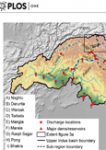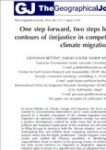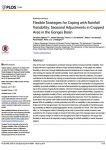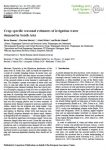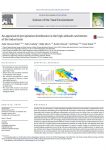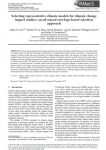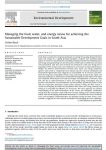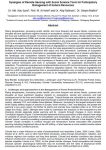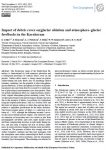Climate Change Impacts on the Upper Indus Hydrology: Sources, Shifts and Extremes
Peer Reviewed Journal Article, 2016
The Indus basin heavily depends on its upstream mountainous part for the downstream supply of water while downstream demands are high. Analysis of future hydrological extremes reveals that increases in intensity and frequency of extreme discharges are very likely for most of the upper Indus basin and most ensemble members.
“One step forward, two steps back? The fading contours of (in)justice in competing discourses on climate migration”
Peer Reviewed Journal Article, 2016
Lately, a number of less alarmist framings have gained ground and offer alternative understandings of how environmental and climate changes interact with human mobility –including the idea that migration might be a legitimate adaptation strategy. While this evolution has favored a defusing of tones, there remains a critical gap in understanding the climate-migration nexus. The paper addresses this gap.
Flexible Strategies for Coping with Rainfall Variability : Seasonal Adjustments in Cropped Area in the Ganges Basin
Peer Reviewed Journal Article, 2016
One of the main manifestations of climate change will be increased rainfall variability. How to deal with this in agriculture will be a major societal challenge. In this paper we explore flexibility in land use, through deliberate seasonal adjustments in cropped area, as a specific strategy for coping with rainfall variability. Such adjustments are not incorporated in hydro-meteorological crop models commonly used for food security analyses. Our paper contributes to the literature by making a comprehensive model assessment of inter-annual variability in crop production, including both variations in crop yield and cropped area.
Crop-specific seasonal estimates of irrigation-water demand in South Asia
Peer Reviewed Journal Article, 2016
In the Himalayan headwaters of the main rivers in South Asia, shifts in runoff are expected as a result of a climate change. Although our insight into these shifts and their impact on water availability has increased, a similar detailed understanding of the seasonal pattern in water demand is absent. This hampers a proper assessment of water stress and ways to cope and adapt. In this study, the seasonal pattern of irrigation-water demand resulting from the typical practice of multiple cropping in South Asia was accounted for by introducing double cropping with monsoon-dependent planting dates in a hydrology and vegetation model.
An appraisal of precipitation distribution in the high-altitude catchments of the Indus basin
Peer Reviewed Journal Article, 2016
Here, the study analyses altitudinal dependency of precipitation in the high-altitude Indus basin by combining most of the available station data with the indirect precipitation estimates at the accumulation zones of major glaciers. It uses Kriging with External Drift (KED) interpolation scheme with elevation as a predictor to appraise spatio-temporal distribution of mean monthly, seasonal and annual precipitation for the period 1998–2012. Results show clear non-linear increases in precipitation with altitude. The estimated precipitation is much higher compared to previous studies and gridded products. The gridded precipitation products are unsuitable to force hydrological models in upper Indus.
Selecting representative climate models for climate change impact studies: an advanced envelope-based selection approach
Peer Reviewed Journal Article, 2016
Usually, the selection of climate models is either based on the entire range of changes in climatic variables as projected by the total ensemble of available climate models or on the skill of climate models to simulate past climate. The present study combines these approaches in a three-step sequential climate model selection procedure for a study area covering the Indus, Ganges and Brahmaputra river basins. Subsequently, the changes in climate between 1971–2000 and 2071–2100 are analysed, showing that the future climate projections in this area are highly uncertain but that changes are imminent.
Managing the food, water, and energy nexus for achieving the Sustainable Development Goals in South Asia
Peer Reviewed Journal Article, 2015
The nexus approach can enhance understanding of the interconnectedness of the food-water-energy sectors and strengthen coordination among them. But it requires a major shift in the decision-making process towards taking a holistic view and developing institutional mechanisms to coordinate the actions of diverse actors and strengthen complementarities and synergies among the three sectors. A framework is suggested for cross-sectoral coordination and managing the nexus challenges, with a view toward meeting the Sustainable Development Goals in South Asia.
Synergies of Remote Sensing with Social Science Tools for Participatory Management of Natural Resources
Peer Reviewed Journal Article, 2015
This study undertaken in the Himachari National Park (HNP) in Bangladesh demonstrates potentials and importance of iterative and interactive use of geospatial and social science techniques and tools in synergistic approach for sustainable development and adaptation. The potential synergies and complementarities among GIS and social science methods and tools may be used to guide formulation of effective adaptation options. The research highlighted the need for a shift in policy approaches from a conventional ecosystem only or society only focus, which may result in unsustainable ecosystem services; to an integrated approach with policy coherence at national down to landscape level.
High-resolution modelling of atmospheric dynamics in the Nepalese Himalaya
Peer Reviewed Journal Article, 2015
High-altitude meteorological processes in the Himalaya are influenced by complex interactions between the topography and the monsoon and westerly circulation systems. The study used the Weather Research and Forecasting model configured with high spatial resolution to understand seasonal patterns of near-surface meteorological fields and precipitation processes in the Langtang catchment in the central Himalaya. The study concludes that there is great potential for improving the local accuracy of climate change impact studies in the Himalaya by using high-resolution atmospheric models to generate the forcing for such studies.
Impact of debris cover on glacier ablation and atmosphere–glacier feedbacks in the Karakoram
Peer Reviewed Journal Article, 2015
To date, the influence of debris on Karakoram glaciers has only been directly assessed by a small number of glaciological measurements over short periods. Here, supraglacial debris is included in a high-resolution, interactively coupled atmosphere–glacier modeling system to understand glaciological and meteorological changes that arise due to the presence of the debris.

